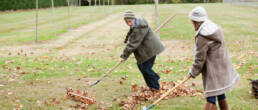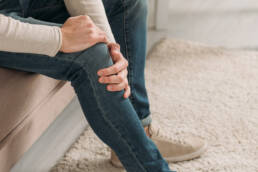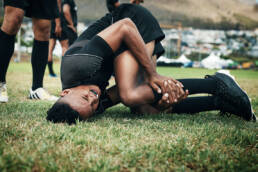With shorter days and falling leaves blanketing the nation, many of us are rushing to take care of last-minute outdoor tasks before the coming winter months. Whether you love it or hate it, cleaning up fallen leaves is one of those tasks that most homeowners must tackle. Raking leaves is great exercise, but when not done carefully, it can lead to injuries due to the repetitive motions. Here are just a few simple tips for preventing aches and pains when raking leaves.
How to Prevent Aches and Pains When Raking Leaves
Stretch Before You Get Started
Before you pick up the rake, do about 10 to 15 minutes of stretching exercises. Focus on stretching your back, hips, shoulders and neck.
Use the Right Equipment

Look for a rake that is made of flexible plastic or steel or bamboo, and make sure it is proportionate to your body size. Selecting the right size helps ensure that your posture won’t have to overcompensate while you are working.
Opt for Appropriate Footwear
When you’re working in the yard, leave your flip flops inside – no matter how nice the weather is. Wear shoes or boots that have good support and slip-resistant soles.
Maintain Good Form
Avoid strain by keeping your legs bent and your weight centered. Rather than twisting at the waist while raking, put one foot in front of the other in line with the direction you are raking. This allows you to shift forward and backward more naturally.
Use Your Knees
When lifting to load leaves into yard bags, bend your knees and keep your back straight. Let your legs do the heavy lifting instead of your back.
Don’t Ignore Warning Signs
It’s normal to feel a little soreness and fatigue while engaging in physical activity. If, however, you feel serious pain, it’s important to stop right away. If you experience ongoing discomfort or pain following physical activity, have yourself checked for sprains and strains. If you’re in need of a physical therapist in Denver, contact Denver Physical Medicine. Call 303-757-7280.
Ready for an expert opinion? Get in touch today!
Discover how physical therapy can help manage scoliosis in mild to moderate cases, along with other ways it offers healthcare solutions. Learn more from Dr. Mansi Dua, DPT, C2 Schroth Certified.
Like this article? Spread the word!
Related Posts
April 15, 2025
Spring into Motion: Why Now is the Perfect Time to Start Physical Therapy
Discover why spring is ideal for starting physical therapy. Custom rehab, massage therapy…
April 15, 2025
Spring Sports Conditioning: Rehab Tips for Runners, Cyclists & Golfers in Denver
From knee pain to swing mechanics, get ahead of spring sports injuries. PT tips for…
March 10, 2025
Comprehensive Physical Therapy at Denver Physical Medicine & Rehab
Discover expert physical therapy services at Denver Physical Medicine & Rehab. Our…





